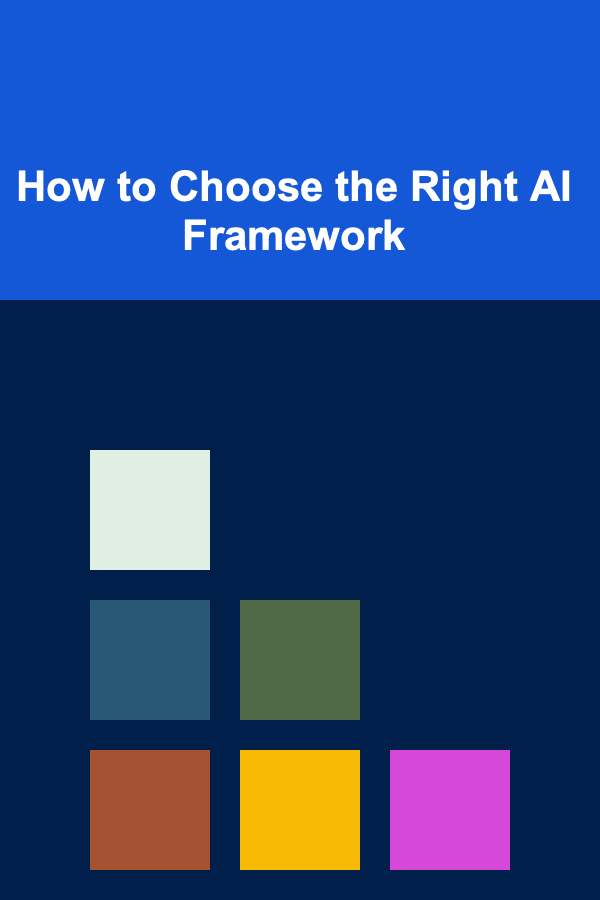
How to Choose the Right AI Framework
ebook include PDF & Audio bundle (Micro Guide)
$12.99$10.99
Limited Time Offer! Order within the next:

In the rapidly evolving landscape of Artificial Intelligence (AI), selecting the appropriate framework is a crucial decision that can significantly impact the success of your AI projects. An AI framework acts as a foundation, providing the necessary tools, libraries, and abstractions to streamline the development, training, and deployment of AI models. However, with a plethora of options available, choosing the right framework can be a daunting task. This article delves into the critical factors to consider when selecting an AI framework, offering a comprehensive guide to navigate the complexities and make an informed decision.
Understanding AI Frameworks: A Foundation for Success
Before diving into the selection process, it's essential to understand what AI frameworks are and the role they play in AI development. An AI framework is a pre-built set of tools and libraries designed to simplify the creation of AI applications. They abstract away many of the low-level details, allowing developers to focus on the core logic of their models and algorithms. Think of them as a construction kit for building AI models, providing the necessary components and instructions to assemble a functional and efficient system.
Key benefits of using AI frameworks include:
- Accelerated Development: Frameworks offer pre-built functionalities, reducing the need to write code from scratch and speeding up the development process.
- Simplified Model Building: They provide intuitive APIs and abstractions for building complex AI models with ease.
- Optimized Performance: Frameworks often incorporate optimized algorithms and hardware acceleration techniques for improved performance.
- Community Support: Popular frameworks boast large and active communities, providing ample support and resources.
- Deployment Capabilities: Many frameworks offer tools and integrations for seamless deployment of AI models to various environments.
Key Considerations for Choosing an AI Framework
Selecting the right AI framework requires careful evaluation of several factors that align with your project requirements, team expertise, and long-term goals. Here's a detailed breakdown of the key considerations:
1. Project Requirements: Matching the Framework to the Task
The most critical factor is aligning the framework with the specific requirements of your AI project. Different frameworks excel in different areas. For instance:
- Deep Learning (Computer Vision, NLP): TensorFlow and PyTorch are dominant players in deep learning, offering extensive features and flexibility for building complex neural networks.
- Classical Machine Learning: Scikit-learn is a versatile library for classical machine learning tasks such as classification, regression, and clustering.
- Reinforcement Learning: TensorFlow, PyTorch, and specialized frameworks like Ray offer robust support for reinforcement learning algorithms.
- Edge Computing: TensorFlow Lite and PyTorch Mobile are designed for deploying AI models on resource-constrained devices.
Consider the following questions:
- What type of AI model are you building? (e.g., image recognition, natural language processing, time series analysis)
- What data types will you be working with? (e.g., images, text, numerical data)
- What is the scale of your data and model? (e.g., small dataset, large-scale distributed training)
- What are the performance requirements? (e.g., latency, throughput)
- Where will the model be deployed? (e.g., cloud, edge device, mobile app)
Answering these questions will help narrow down the options and identify frameworks that are best suited for your specific project.
2. Programming Language Proficiency: Leveraging Existing Skills
Most AI frameworks are built on popular programming languages like Python, Java, and C++. Choosing a framework that aligns with your team's existing programming language proficiency can significantly reduce the learning curve and accelerate development. For example:
- Python: TensorFlow, PyTorch, Scikit-learn, Keras
- Java: Deeplearning4j
- C++: TensorFlow (with C++ API), Caffe
If your team is already proficient in Python, leveraging frameworks like TensorFlow or PyTorch will allow them to quickly get up to speed and start building AI models. Introducing a new language solely for using a specific framework can lead to delays and increased development costs.
3. Community Support and Documentation: A Lifeline for Developers
A strong and active community and comprehensive documentation are invaluable resources when working with any AI framework. A large community provides access to support forums, tutorials, pre-trained models, and code examples, making it easier to troubleshoot problems and learn new techniques.
Consider the following factors:
- Community Size: How large and active is the community?
- Documentation Quality: Is the documentation comprehensive, well-organized, and easy to understand?
- Availability of Tutorials and Examples: Are there plenty of tutorials and code examples available to help you get started?
- Support Channels: Are there forums, mailing lists, or other channels where you can ask questions and get help?
Frameworks with robust community support and documentation often lead to faster development, fewer roadblocks, and a more positive development experience. Look for frameworks that are actively maintained and have a thriving community of users.
4. Performance and Scalability: Optimizing for Efficiency
The performance and scalability of an AI framework are critical for handling large datasets and complex models. Consider the following aspects:
- Hardware Acceleration: Does the framework support hardware acceleration using GPUs or other specialized hardware?
- Distributed Training: Does the framework offer capabilities for distributed training across multiple machines or GPUs?
- Optimization Techniques: Does the framework incorporate optimization techniques such as automatic differentiation, graph optimization, and quantization?
For projects that involve large datasets or computationally intensive models, choosing a framework that supports hardware acceleration and distributed training is essential for achieving acceptable performance. Benchmarking different frameworks on your specific dataset and model architecture can help you identify the most performant option.
5. Deployment Options: From Development to Production
The ease of deployment is a crucial factor to consider, especially if you plan to deploy your AI models to production environments. Different frameworks offer varying levels of support for deployment to different platforms, such as:
- Cloud Platforms: AWS, Google Cloud, Azure
- Edge Devices: Mobile phones, embedded systems
- Web Applications: REST APIs, web services
Consider the following questions:
- Where will the model be deployed? (e.g., cloud, edge device, mobile app)
- What deployment formats are supported? (e.g., TensorFlow SavedModel, ONNX)
- Are there tools and integrations for seamless deployment to your target platform?
Choosing a framework that provides the necessary deployment tools and integrations can significantly simplify the deployment process and reduce the time to market. For example, TensorFlow Serving provides a robust and scalable platform for serving TensorFlow models, while TensorFlow Lite is optimized for deploying models on mobile and embedded devices.
6. Licensing and Cost: Considering Long-Term Implications
The licensing terms of an AI framework can have significant implications for its usage and distribution. Most popular AI frameworks are open-source, but it's important to understand the specific license terms and any restrictions that may apply. For example:
- Apache 2.0: A permissive license that allows you to use, modify, and distribute the framework for both commercial and non-commercial purposes.
- MIT License: Another permissive license that is similar to the Apache 2.0 license.
- GPL License: A copyleft license that requires you to make your source code available if you distribute modified versions of the framework.
Consider the following questions:
- What are the licensing terms of the framework?
- Are there any restrictions on commercial use?
- Are there any ongoing costs associated with using the framework? (e.g., subscription fees, support contracts)
Choosing a framework with a permissive open-source license provides greater flexibility and reduces the risk of vendor lock-in. Also, factor in the potential costs associated with training, deployment, and maintenance when evaluating different frameworks.
7. Maturity and Stability: Balancing Innovation and Reliability
The maturity and stability of an AI framework are important factors to consider, especially for projects that require long-term reliability and support. A mature framework has typically undergone extensive testing and has a proven track record of stability.
Consider the following indicators of maturity:
- Number of Releases: How many major releases has the framework had?
- Time Since Last Release: When was the last major release?
- Bug Fixes and Patches: How frequently are bug fixes and patches released?
- Community Feedback: What is the general sentiment of the community regarding the stability of the framework?
While newer frameworks may offer innovative features and cutting-edge capabilities, they may also be less stable and have fewer resources available. It's important to strike a balance between innovation and reliability when choosing an AI framework. For mission-critical applications, opting for a mature and stable framework is generally recommended.
Comparing Popular AI Frameworks: A Closer Look
Let's take a closer look at some of the most popular AI frameworks and their key characteristics:
TensorFlow
TensorFlow is a comprehensive open-source machine learning framework developed by Google. It offers a wide range of features and tools for building and deploying AI models, including:
- Deep Learning Focus: Excellent for building and training complex neural networks.
- Keras Integration: Seamless integration with Keras, a high-level API for building and training neural networks.
- Hardware Acceleration: Supports hardware acceleration using GPUs and TPUs (Tensor Processing Units).
- Distributed Training: Provides robust support for distributed training across multiple machines or GPUs.
- Deployment Options: Offers tools for deploying models to various platforms, including cloud, edge devices, and mobile apps (TensorFlow Lite).
- Large Community: Boasts a large and active community, providing ample support and resources.
TensorFlow is a great choice for projects that involve deep learning, require high performance, and need to be deployed to various environments. However, its API can be complex and challenging to learn for beginners.
PyTorch
PyTorch is another popular open-source machine learning framework developed by Facebook. It is known for its flexibility, ease of use, and strong support for dynamic computation graphs.
- Dynamic Computation Graphs: Allows for more flexible and intuitive model building and debugging.
- Pythonic Interface: Offers a Pythonic interface that is easy to learn and use.
- Strong Community: Has a rapidly growing and active community.
- Research-Oriented: Popular in the research community due to its flexibility and ease of experimentation.
- Hardware Acceleration: Supports hardware acceleration using GPUs.
- Deployment Options: Provides tools for deploying models to various platforms, including cloud and mobile apps (PyTorch Mobile).
PyTorch is a good choice for projects that require flexibility, ease of use, and strong community support. It is particularly well-suited for research and development, as well as projects that involve dynamic computation graphs. The transition to production environments can be less straightforward than TensorFlow.
Scikit-learn
Scikit-learn is a versatile open-source machine learning library for Python. It provides a wide range of algorithms for classical machine learning tasks, such as:
- Classification: Logistic regression, support vector machines, decision trees
- Regression: Linear regression, polynomial regression, decision tree regression
- Clustering: K-means clustering, hierarchical clustering
- Dimensionality Reduction: Principal component analysis (PCA), t-distributed stochastic neighbor embedding (t-SNE)
- Model Selection: Cross-validation, hyperparameter tuning
Scikit-learn is easy to use, well-documented, and has a large and active community. It is a good choice for projects that involve classical machine learning tasks and don't require deep learning capabilities. It's also excellent for getting a quick baseline model up and running.
Keras
Keras is a high-level API for building and training neural networks. It can run on top of TensorFlow, PyTorch, or other backends. Keras focuses on user experience, making it easy to prototype and experiment with different neural network architectures.
- Ease of Use: Provides a simple and intuitive API for building and training neural networks.
- Flexibility: Can run on top of various backends, including TensorFlow and PyTorch.
- Modular Design: Offers a modular design that allows you to easily combine different layers and components.
- Extensive Documentation: Has excellent documentation and a large and active community.
Keras is a good choice for beginners who are new to deep learning, as well as experienced developers who want to quickly prototype and experiment with different neural network architectures. It simplifies the process of building and training neural networks, allowing you to focus on the core logic of your models.
Deeplearning4j (DL4J)
Deeplearning4j is an open-source, distributed deep-learning library for the Java Virtual Machine (JVM). It's designed for building, training, and deploying neural networks in Java and Scala environments.
- Java/JVM Integration: Seamlessly integrates with Java and other JVM languages like Scala and Kotlin.
- Production Focus: Designed for enterprise-level deployments and production environments.
- Distributed Computing: Supports distributed training and inference on clusters of machines.
- Hardware Acceleration: Utilizes GPUs and CPUs for accelerated computation.
- Microservices Architecture: Well-suited for integrating AI models into microservices-based applications.
DL4J is ideal for organizations with existing Java infrastructure and a need for deep learning capabilities within that ecosystem. It's particularly useful for building scalable and robust AI applications for enterprise environments.
A Practical Framework Selection Process
Here's a step-by-step process you can follow to choose the right AI framework:
- Define Your Project Requirements: Clearly define the goals, data types, model types, performance requirements, and deployment environment for your project.
- Assess Your Team's Skills: Evaluate your team's existing programming language proficiency and AI expertise.
- Research Potential Frameworks: Identify a shortlist of frameworks that align with your project requirements and team skills.
- Evaluate Community Support and Documentation: Assess the community size, documentation quality, and availability of tutorials and examples for each framework.
- Benchmark Performance: Benchmark the performance of different frameworks on your specific dataset and model architecture.
- Consider Deployment Options: Evaluate the ease of deployment to your target platform and the availability of deployment tools and integrations.
- Evaluate Licensing and Cost: Understand the licensing terms of each framework and any potential costs associated with its use.
- Test and Prototype: Test and prototype with your top framework choices on a smaller scale before committing to a full-scale implementation.
- Make an Informed Decision: Based on your research and evaluation, choose the framework that best meets your needs and constraints.
Conclusion: Choosing Wisely for AI Success
Selecting the right AI framework is a strategic decision that can significantly impact the success of your AI projects. By carefully considering the factors outlined in this article, you can make an informed decision that aligns with your project requirements, team expertise, and long-term goals. Remember to continuously evaluate and adapt your framework choices as your projects evolve and the AI landscape continues to change. The key is to choose a framework that empowers your team to build, train, and deploy AI models effectively and efficiently, ultimately driving innovation and achieving your desired business outcomes.

How to Add a Touch of Glamour to Your Home on a Budget
Read MoreHow to Create a System for Tracking Home Maintenance
Read More
How to Design a Serene and Organized Bedroom Retreat
Read More
How to Make Money Online as a Retail Store Manager: 10 Actionable Ideas
Read More
How to Make Your Home Safe for Pet Birds
Read More
How to Understand Space Debris
Read MoreOther Products

How to Add a Touch of Glamour to Your Home on a Budget
Read MoreHow to Create a System for Tracking Home Maintenance
Read More
How to Design a Serene and Organized Bedroom Retreat
Read More
How to Make Money Online as a Retail Store Manager: 10 Actionable Ideas
Read More
How to Make Your Home Safe for Pet Birds
Read More